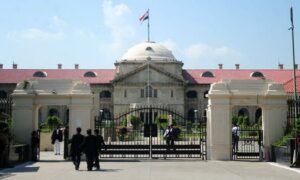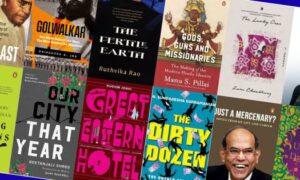
Shad Naved’s The Ghazal Eros: Lyric Queerness in History is a long-awaited study. This book has been anticipated not only as an important scholarly intervention but also as a distillation of Naved’s erudition. That expectation is more than fulfilled – The Ghazal Eros is a brilliant, original contribution to literary and queer studies that opens new ways of thinking about the history and poetics of the ghazal as well as gendered content.
The ghazal has seen a remarkable resurgence – not just in South Asia, but globally. A couple of years ago, I was on the jury for the Oxbelly literary retreat, which takes place annually in Greece. I had the opportunity to review around 60 poems submitted from across the world, offering feedback and selecting work for recognition as part of the retreat’s poetry program. To my surprise, nearly a third of them were ghazals, many written by young poets from Nigeria, the UK, the Philippines, and elsewhere – a clear sign of how widely the form is resonating today. I’ve also been teaching a course on the ghazal at Cornell University, as part of South Asian literature, which quickly became popular with students drawn to the genre’s emotional range and formal intricacies.
Sexual orientation as style
This recent revival of the ghazal makes Shad Naved’s The Ghazal Eros: Lyric Queerness in History especially timely. At its core, the book dismantles the entrenched notion that the ghazal – often defined in pre-colonial, colonial and postcolonial lexicons as a heterosexual love lyric – was ever primarily that. Those of us who studied Urdu in school might remember how our teachers used to read from our textbooks – “Ghazal ke ma’ne hain aurton se baatein karna ya unki tareef karna.” It was usually followed by a chuckle or a half-smile. Backed by research, Naved shows how across Arabic, Persian and Urdu traditions, the ghazal evolved as a genre by expanding its lyric queerness: an aesthetic mode wherein male poets wrote overwhelmingly about men. This was not a hidden, suppressed undercurrent but an explicit and historically meaningful stylistic orientation.
The strength of Naved’s argument is that he does not reduce queerness in the ghazal to questions of individual identity or authorial sexuality. Rather, he theorises “sexual orientation as style” – as a formal mode embedded in the ghazal. The style of the ghazal remains dynamic, continuously evolving rather than fixed or immutable and Naved traces that evolution through the 18th century which is the period of important shifts in the Indian subcontinent.
This book offers a compelling corrective to recent queer readings that isolate certain poets or verses as “exceptions”, while ignoring the historical lyric queerness of the genre itself. One of the book’s many achievements lie in its comparative and multilingual reach. Naved moves fluently across Arabic, Persian, and Urdu texts, situating the Urdu ghazal in a wider transregional history. His command of these languages and their literary traditions (particularly the history of mysticism in which the ghazal plays an important part) is remarkable, and this shines in his own translations. Naved provides versions historically accurate as well as linguistically faithful translations of both well-known poets like Mir Taqi Mir and lesser known as Abru, Naji and Zatalli.
Drawing on a wide historical arc – from the Umayyad period through the Abbasid empire and into the imperial cities of Baghdad, Basra, Kufa, Shiraz, and Delhi – the book reflects the author’s meticulous research into the shifting topographies of the ghazal. The analysis of urban versus desert erotic conventions and the nuanced reading of poets such as Abu Nuwās, Hāfiz, and Mir underscores the depth of the author’s scholarly engagement with lyric transformation across periods and geographies.
How to read a ghazal
The later chapters extend the argument beyond Urdu, touching on classical Persian, classical Arabic and hinting at lesser studied traces of the ghazal in Bosnian and Kashmiri literature in order to show that the ghazals themes have developed and changed in relation to powerful structures like the state, mysticism and philosophy. The author recovers the figures of Mansoor Hallaj and Sarmad who are shown to be crucial thinkers of lyric queerness which influenced the writing of the ghazal across the multilingual literatures of the ghazal. Zikr-e-Mir, (Mir’s memoir) is recovered as book that reads mystical training itself as a social history of homoerotic desire, while the dialectic between restraint (Ibn Davud) and ecstatic passion (Hallaj, Sarmad) charts how ishq evolved as both spiritual and political expression – sometimes culminating in acts of defiance and martyrdom. In engaging critically with “queer Sufism” and modern readings of ishq, Naved invites us to confront the layered, historically contingent meanings of passion that animate the ghazal’s enduring life.
In sum, The Ghazal Eros offers not simply “new things” to say about the ghazal – it proposes an entirely new way of reading this foundational genre of Indo-Persianate and Perso-Arabic literatures. By insisting on the historical centrality of lyric queerness, and by tracing its transformations across languages, Naved recasts our understanding of both the ghazal’s past and its ongoing cultural advances. His mastery of languages, critical theory, and literary history makes this book essential reading for scholars of Arabic, Urdu, Persian, comparative literature, and queer studies alike.
Naved’s command over languages shines through the translations of couplets. In terms of curation, it is pertinent to mention that the selection of couplets achieves a remarkable sense of narrative continuity (tasalsul), even in English translation. Even if these couplets were read without the book’s critical commentary, they would still produce a satisfying coherence. This coherence not only reveals the structural richness of the book but also reinforces the underlying argument about lyric queerness as an inherent, historically self-aware dimension of the tradition.
Asiya Zahoor is an academic and a writer. She teaches at a college in Baramulla in Kashmir.
The Ghazal Eros: Lyric Queerness in History, Shad Naved, Tulika Books.
📰 Crime Today News is proudly sponsored by DRYFRUIT & CO – A Brand by eFabby Global LLC
Design & Developed by Yes Mom Hosting






